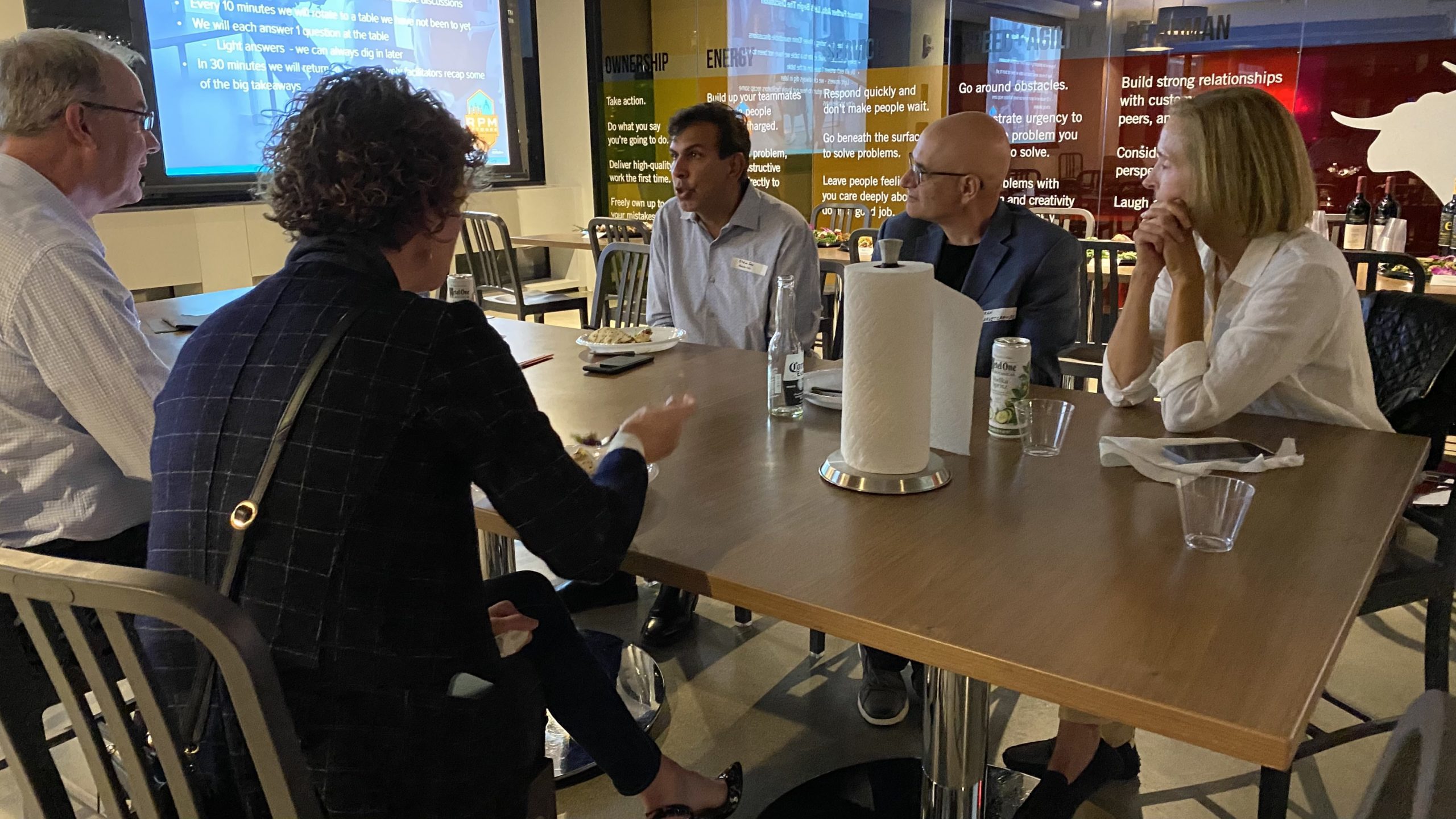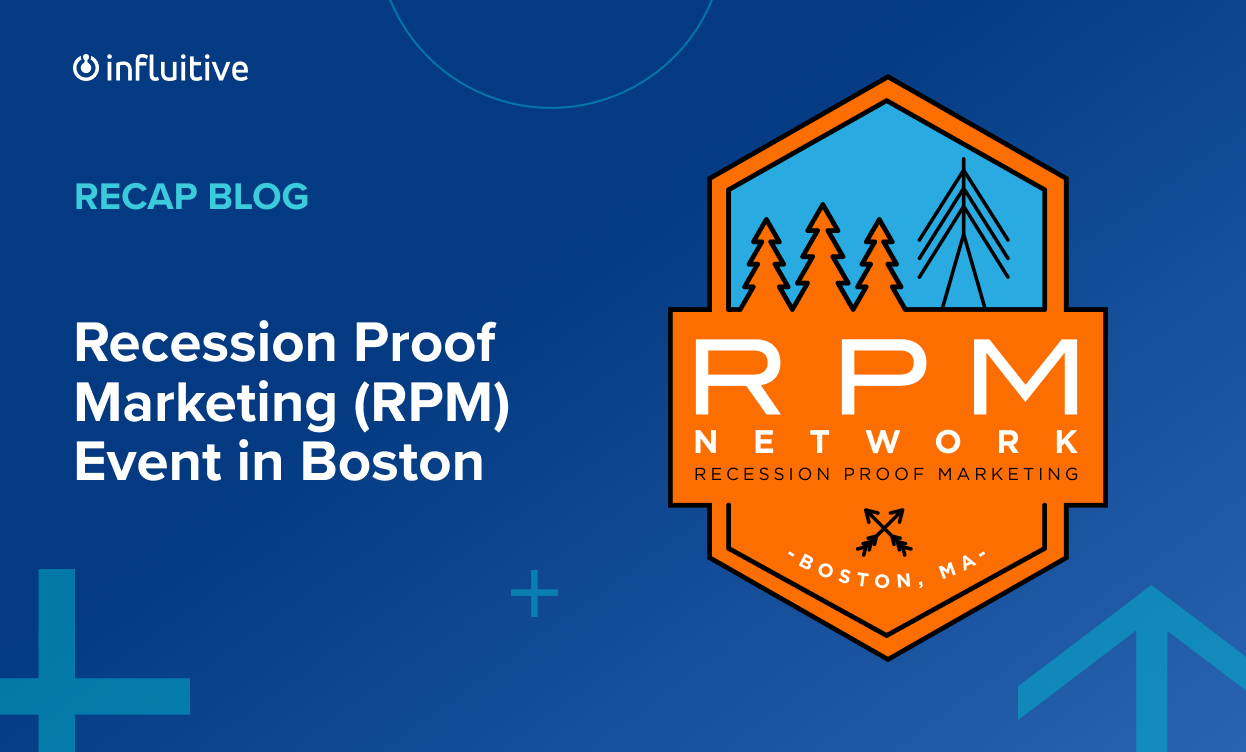Last month, the Influitive leadership team kicked off our first ever Recession Proof Marketing (RPM) event in Boston.
We brought together some customer marketing executives to brainstorm how today’s marketing teams can drive profitability in or out of a recession environment.
“You need like-minded marketers [and] executives that are trying to solve big problems around how to grow the business in times that are a little bit uncertain.”
Gordon Burnes, Chief Marketing Officer at Bullhorn
The world is entering economic uncertainty. Today’s marketing leaders are under increasing pressure to deliver more, but with less. They won’t have as much to spend, nor enough people to deliver on those demands.
It’s a challenge, but does it mean we should expect to fail?
We say: Absolutely not!

RPM was a great opportunity for us to learn from marketing executives (customers and attendees) on how leaders should navigate a looming recession. They helped us see how they’re using an antifragile approach to rise from the current chaos stronger than ever.
Here are some of the big takeaways from the event:
We’re Now in Choppy Economic Waters

Not only do the responses to Pavilion’s Pulse Benchmarking Survey clearly demonstrate that we’re in economic turbulence, but the constant influx of news within our marketing communities of layoffs, budget cuts, and hiring freezes supports this. Companies across industries are facing the fallout, and we need to take it seriously.
But that doesn’t mean we brace for declining revenue and profit. Rather, we should recalibrate our marketing spend to focus on the customer — our tried and true champions that help guide the way through troubled waters.
By doing so, we can even drive positive outcomes in harsh economic times – and unlock streams of incredible potential for when we move into a bull-market.
It’s Time to Focus on Your Customers
Forrester’s research shows that 80% of a company’s revenue comes from existing customers.
This isn’t surprising. Fred Reichheld – the inventor of the Net Promoter System – found that increasing customer retention by 5% increases profits by 25% to 95%.
This rule holds true to this day.
Moreover, it can cost 5X more to acquire a new customer than to retain one.
So, it doesn’t make sense to allocate most of your marketing spend to target net-new customers when you already have an incredible growth engine available.
I know it’s hard to make the case that existing should trump net new logo acquisition. But the companies that are doing so are reaping the rewards while you’re playing a cat and mouse game within an ever increasingly large maze.
So, does your customer marketing budget reflect this reality?
Customer marketing isn’t just another marketing specialization. Rather, it’s the glue for your entire organization. It is (and can be for you) the central operating system for your adoption, engagement, and revenue cycles.
Customer marketing creates a ‘visible’ link for internal teams to communicate with customers while championing your customers’ experience in your company.
Here’s how you do it:
5 Bulletproof Marketing Strategies to Beat a Recession
1. Focus on Community
The fastest-growing and most profitable companies are customer-obsessed. They engage their customers and act upon customer needs, wants, and motivations. And communities play a core role in driving this approach.
Don’t relegate your communities in a passive support function. Not only is this a very suboptimal experience for your customers, but it leaves a lot of growth potential on the table.
Rather, shape your community into a valuable resource for learning your product. Ensure your customers get the support, information, and training they need to excel both as employees for their companies and as professionals in their careers.
Use your community to build relationships with your customers – and between your customers.
2. Champion Authentic Stories
70% of consumers distrust marketers (Gartner). Your prospects don’t want to be marketed or sold to. Rather, they want to be in control of the buying journey, and they want to consult the sources they see as credible and trustworthy – i.e., your customers. There is absolutely nothing more trustworthy than people who are currently using your products and services.
In fact, 70% of the buyer’s journey is complete by the time a prospect reaches out to the sales team (Forrester). They’ve mostly made up their decision.
To truly connect with prospects before that point, you need to lean on authentic stories that put your customers at the center. They are the champions of the story. They’re the ones who will inspire your next round of new recruits to join in on the mission.
Finally, the strongest content comes from your champions – i.e., through their reviews, testimonials, expertise, and other user-generated content (UGC).
3. Rally Your Employees
Having a smaller marketing team doesn’t mean having fewer marketers.
Start mobilizing your employees to be active on social media. The branded content shared by employees gets 5X more reach than official company accounts.
This doesn’t simply mean having every employee turn into a social spam engine, where everyone just shares the exact same posts.
Rather, you should elevate your employees into thought leaders and expert problem-solvers who join and steer the conversation. They’ll help extend your brand reach and bring in a more diverse perspective to resonate with a larger audience. They can start engaging and helping prospects long before those prospects talk to your sales team.
4. Arm Your Advocates
When making purchase decisions, people trust content from other people more than content from brands. You need your customers to be your advocates.
There is nothing more powerful than what your customers say about you when you’re not in the room, whether that room is real or digital.
Prospects are not only going to rely on the references you supply. Rather, they’re going to meet, listen, reach out to, and connect with those you haven’t manicured for the conversation. Your advocates need to be ready and excited to continue the conversation wherever it finds them.
However, you can’t just expect your happiest and most satisfied customers to promote your company. You need to mobilize them. Build programs that drive engagement – which leads to referrals, references, reviews, and social media participation.
Let your customers shine on the big (and little) stages around the world. Remember, the more empowered they are with their own journey, the further the trip you will take with them. They are the captain driving your brand’s speed boat.
5. Level Up Your Customer Marketing
No more lip service!
One more time, “No more lip service!”
It’s time to invest in your most powerful engine: customers.
If we haven’t demonstrated the case through the overwhelming evidence already cited from the analysts (that there is no stronger growth engine) then hear this…
Your customers spend most of their time not as prospects, but as…customers.
Your customer marketers play the leading role in scaling the communication and effectiveness of your post-sale journey towards advocacy.
Customer marketers also connect and reconnect customers to your key internal teams so you can achieve departmental and organizational goals. High-performing organizations are 3X more likely to report a significant investment in customer marketing.
3 Takeaways from the Attendees

1. Leverage Your Non-Marketing Employees
Your internal teams are a treasure trove of knowledge and expertise. Tap into their insights to create unique and credible thought leadership. Utilize their know-how to help your customers learn your products/services through training, certifications and workshops.
Not only do customers get more value from your brand, but your internal teams also start building rapport with your customers. This deepens the customer’s confidence in your brand and also creates cross-departmental buy-in for advocacy.
Your customer marketers play a key role in creating buy-in for interactions between customers and internal teams, especially among your CSMs/AEs.
2. Empower Your Customers
Carry the voice of the customer across your internal teams. Invest in authentic content assets that deliver social proof centered on your customers.
Elevate your customers’ careers. Look beyond the company they work for and their roles – engage the actual person. Design programs that help your customers grow as professionals, e.g., a certification program, speaking at events, and opportunities to upskill.
Help your customers grow their networks. Get them to connect with their peers and industry leaders. Support them in reaching new career growth opportunities.
Build communities that provide the best answers to your customers’ questions or concerns. See what you can do to make finding best practices, tips and strategies easy so that your customers see their jobs getting easier.
3. Bring Value Beyond Your Product
Today, an excellent product is table stakes. It’s a given – and at the same time, it’s not the thing that’ll guarantee customer loyalty or engagement.
You need to go above and beyond to deliver value. If you can turn your customers into internal champions at their own organizations, they will more likely continue to mature on the external stage as well. Value selling is as much a customer game as it is a prospect one.
You should be able to provide peer-to-peer complimentary training and certification programs, for example.
Likewise, if you can closely collaborate with your advocates so that they meet—and exceed—the goals they set out when they chose your product, now they have the body of context to share with the world.
By helping them navigate their own organizations to generate internal buy-in, especially with their other teams and executives/leaders, you will begin to set a course with them that will inspire your next wave of sailors. These are your captains that will navigate the choppy, smooth, and everything in between-waters for you.
Want to Level Up Your Customer Marketing?

You’ll want to stay tuned for our upcoming events – both virtual and in-person.
“Lifting your head up and getting out of your day-to-day, meeting people from different organizations, having different opinions, and experiencing debate in person again is, I think, frankly addictive.”
Gillian Farquhar, Vice President, Customer Marketing at Qlik.
RPM gave attendees an opportunity to test and validate their ideas with input from their best peers. They left the event with actionable strategies they can put to use to navigate today’s economic climate and come out stronger.












































